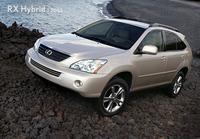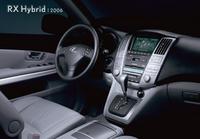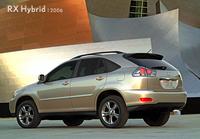Preview: 2006 Lexus RX400h
By Carey Russ
SEE ALSO: New Car Buyer's Guide for LexusPALM SPRINGS, CA: Seven years since the debut of the Lexus RX300? My, how time flies. The RX was one of the most significant vehicles in recent automotive history, as it created the now-burgeoning luxury crossover-SUV category. It quickly became the Lexus sales leader, and its successor, the Lexus RX330, continued that sales success. In addition to being the best-selling Lexus, it is the best-selling luxury SUV. But Lexus never stands still, and has added another model to the RX lineup, the RX400h.
That's ``h'' as in hybrid. When the RX330 was introduced almost two years ago, Lexus announced that a hybrid version was in the works. This was hardly surprising. Lexus's parent company, Toyota, is the leader in gasoline-electric hybrid technology. The Toyota Prius has been very successful, and the technology behind Toyota's hybrid system has been licensed to several other manufacturers. A hybrid crossover would make sense, given the popularity of both the hybrid concept and the use to which such machines are put by their owners, not to mention the cachet that hybrid ownership currently has. But there was a twist. The hybrid would be marketed not merely for its economy and low emissions, but for its performance. An interesting comment, as the Toyota Prius was not exactly known for its accelerative ability.
A quick aside. Back in 1999, I had the opportunity to drive a pre-production Prius. It was part of a ``beta-test'' program to place prototype Priuses with technophile potential buyers in order to see how the car would work in the real world. That Prius was a very different car than the production version that followed. It was nowhere near as refined. If it was an electronic product it would have been made with breadboard circuits, not printed-circuit boards - meaning that it was lacking in complete refinement and had a few pieces of test equipment here and there inside, all the better to gather data for the engineers. And the transitions to and from electric to gas or gas-electric modes were nowhere near as smooth and seamless as they are in the production version. All of that was not unexpected, as it was, after all, an experimental vehicle. The major difference in the driving experience was the torque of the electric motor. An electric motor has maximum torque at zero rpm, all the better for low-speed acceleration, and this one had plenty. It packed a sudden kick that was refined out of the production version in the interests of civility. Not only is there is no reason that a hybrid vehicle cannot have strong acceleration, it is quite simple to make a hybrid with great acceleration - just add a powerful traction motor or two.
And this is what Lexus has done with the RX400h. It takes the ``Hybrid Synergy Drive'' developed in the Prius to the next level by combining next-generation electrical and electronic parts with the 3.3-liter 3MZ-FE V6 gasoline engine. Unlike the Prius engine, it does not use Atkinson cycle valve timing for ultra-efficient operation, so there is some loss of fuel economy, but a relative gain in power. The RX400h is, remember, the high-performance model in the RX lineup. The engine's VVT-i variable valve timing system is modified, and the standard engine's variable-length manifold is disposed of. These changes reduce low-end torque, but that's not the job of the gasoline engine in a hybrid system - that is the job of the electric motors. Because the engine can be shut down in normal operation, the alternator, power steering pump, water pump, and air conditioning compressor are driven electrically, not by belts from the engine. Actually, there is no alternator, as it is functionally replaced by motor-generators.
There are three permanent-magnet motor-generators. MG1 functions as the engine's starter motor, and can be driven by the engine to generate electricity in order to charge the 288-volt nickel-metal hydride (Ni-MH) battery pack that is placed under the rear seat and/or run the other electric motors as needed. It also regulates the output speed of the planetary-gear transaxle and so, indirectly, the speed of the vehicle. MG2 is the front electric motor. It is the primary traction motor, and, along with the gasoline engine inputs motive power to the transaxle and can drive MG1 as a generator. MG3 provides power to the rear axle. Electronic controls decide how to split the font-to-rear torque ratio depending on rate of acceleration and wheelslip. The motor-generator units are cooled by oil and liquid coolant. Regenerative braking boosts efficiency, helps to recharge the battery pack, and increases stopping power.
The gasoline engine makes 208 horsepower at 5600 rpm, with 212 lb-ft of torque at 4400 rpm. MG2 makes 123 kW (167 hp) at 4500 rpm, with 247 lb-ft of torque between 0 and 1500 rpm. MG3 has 50 kW - 68 hp - between 4610 and 5120 rpm and 96 lb-ft of torque between 0 and 610 rpm. Impressive as the torque figures from the electric motors are, they don't tell the complete story. The rear motor spins at very high rpm, and so reduction gears are used on its output shafts. Its 96 lb-ft of torque is multiplied by a factor of nearly seven, making up to 650 lb-ft of torque available for tractive effort. That's noticeable.
Also new, but not particularly surprising, is Vehicle Dynamic Integrated Management, or VDIM. VDIM integrates traction and stability controls in much the same manner as the old Vehicle Stability Control (VSC) system. Unlike VSC, which was a reactive system, VDIM proactively anticipates instability through sensors and computer controls, and works individual brakes and engine and motor power to keep the RX400h pointed in its intended direction. At its heart is electronically-controlled braking (ECB), in which electronic sensors attached to the brake pedal detect pedal stroke speed and pressure and send control signals to both the hydraulic and regenerative braking systems for quick, precise operation. There is a hydraulic backup system.
When the RX400h hits showrooms in mid-April, how will you tell it from an RX330? All of the body panels are shared, but the hybrid has a duct in its front bumper fascia to take in cooling air for the hybrid system. Through- and under-body aerodynamics were cleaned up to give the RX400h the same coefficient of drag as the RX330, further improving fuel economy.
Unfortunately, only a relatively short hour-long drive was possible, and that was mostly in city traffic. Which, actually, is quite likely to be the RX400h's natural habitat. Start it, and it doesn't seem to start. Right - electric-only power at low speeds, just like a Prius. The engine starts smoothly enough. Press hard on the accelerator, and wham! there's a kick like some serious turbo boost just came in. Electric motors make their best torque right when they start, remember? And the RX400h's traction motors produce some serious torque. Lexus says 0-60 time is 7.3 seconds, and that seems about right. Fuel economy is expected to be around 30 mph in town and 26 on the highway. As with the Prius, electric operation at slow speeds and engine stop when the vehicle is stopped contribute to the city rating being higher than highway. Unlike a Prius, there is no shortage of power at highway speeds. For comparison, an AWD RX300 is listed at 18 mpg city, 24 highway, with a 0-60 time of 7.8 seconds. An RX330 was available for testing after I came back from driving the 400h. Big mistake on my part - it felt like the engine was removed. It's not that the 330 is weak - it isn't. But numbers alone do not tell the whole story, and because of the huge torque of the electric motors, the RX400h feels much quicker than mere numbers can tell. While EPA mileage figures should be taken with a grain of salt, especially for hybrids, expect much better fuel economy around town and slightly better mileage than with an RX330 on the highway. And much better performance. Not bad at all.
The price was not revealed at the press introduction, but that hasn't stopped 12,000 people from pre-ordering a 2006 Lexus RX400h. Total production slated for delivery to the U.S. for the year is expected to be around 28,000, and they'll go fast. Hybrid technology is increasingly mainstream, and expect more hybrids from both Lexus and Toyota.





